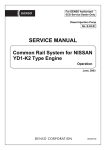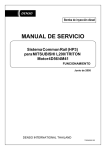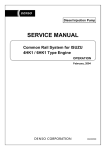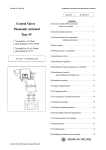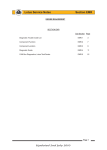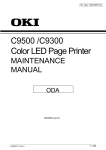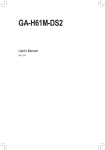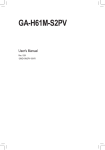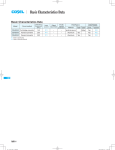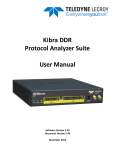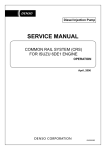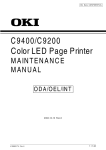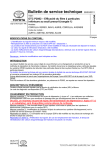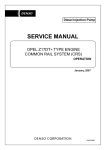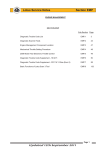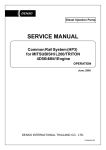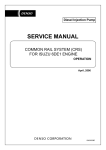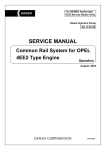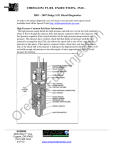Download SERVICE MANUAL - Service
Transcript
For DENSO Authorized ECD Service Dealer Only Diesel Injection Pump No. E-03-01 SERVICE MANUAL Common Rail System for NISSAN YD1-K2 Type Engine Operation June, 2003 00400013E Foreword To meet the high pressurization requirements for the engine to deliver cleaner exhaust gas emissions, lower fuel consumption and reduced noise, advanced electronic control technology is being adopted in the fuel injection system. This manual covers the electronic control model Common Rail system with HP3 pump for the NISSAN YD1-K2 type engine. Complex theories, special functions and components made by manufacturers other than DENSO are omitted from this manual. This manual will help the reader develop an understanding of the basic construction, operation and system configuration of the DENSO manufactured components and brief diagnostic information. TABLE OF CONTENTS 1. Product Application . . . . . . . . . . . . . . . . . . . . . . . . . . . . . . . . . . . . . . . . . . . . . . . . . . . . . . . . . . . . . . . . . . . . . . . . . . . . . . . . . . . . 1 1-1. Application . . . . . . . . . . . . . . . . . . . . . . . . . . . . . . . . . . . . . . . . . . . . . . . . . . . . . . . . . . . . . . . . . . . . . . . . . . . . . . . . . . . . . . . 1 1-2. System Components Parts Number . . . . . . . . . . . . . . . . . . . . . . . . . . . . . . . . . . . . . . . . . . . . . . . . . . . . . . . . . . . . . . . . . . . 1 2. Outline . . . . . . . . . . . . . . . . . . . . . . . . . . . . . . . . . . . . . . . . . . . . . . . . . . . . . . . . . . . . . . . . . . . . . . . . . . . . . . . . . . . . . . . . . . . . . . . 2 2-1. Features of System . . . . . . . . . . . . . . . . . . . . . . . . . . . . . . . . . . . . . . . . . . . . . . . . . . . . . . . . . . . . . . . . . . . . . . . . . . . . . . . . 2 2-2. Outline of System . . . . . . . . . . . . . . . . . . . . . . . . . . . . . . . . . . . . . . . . . . . . . . . . . . . . . . . . . . . . . . . . . . . . . . . . . . . . . . . . . . 4 3. Construction and Operation . . . . . . . . . . . . . . . . . . . . . . . . . . . . . . . . . . . . . . . . . . . . . . . . . . . . . . . . . . . . . . . . . . . . . . . . . . . . . 7 3-1. Description of Main Components . . . . . . . . . . . . . . . . . . . . . . . . . . . . . . . . . . . . . . . . . . . . . . . . . . . . . . . . . . . . . . . . . . . . . 7 3-2. Description of Control System Components . . . . . . . . . . . . . . . . . . . . . . . . . . . . . . . . . . . . . . . . . . . . . . . . . . . . . . . . . . 18 3-3. Various Types of Controls . . . . . . . . . . . . . . . . . . . . . . . . . . . . . . . . . . . . . . . . . . . . . . . . . . . . . . . . . . . . . . . . . . . . . . . . . . 22 4. DTC (Diagnosis Trouble Codes) Table . . . . . . . . . . . . . . . . . . . . . . . . . . . . . . . . . . . . . . . . . . . . . . . . . . . . . . . . . . . . . . . . . . . . 27 4-1. About the Codes shown in the table . . . . . . . . . . . . . . . . . . . . . . . . . . . . . . . . . . . . . . . . . . . . . . . . . . . . . . . . . . . . . . . . . 27 4-2. DTC (Diagnosis Trouble Code) Table . . . . . . . . . . . . . . . . . . . . . . . . . . . . . . . . . . . . . . . . . . . . . . . . . . . . . . . . . . . . . . . . . 27 5. External Wiring Diagram . . . . . . . . . . . . . . . . . . . . . . . . . . . . . . . . . . . . . . . . . . . . . . . . . . . . . . . . . . . . . . . . . . . . . . . . . . . . . . . 34 5-1. ECU External Wiring Diagram . . . . . . . . . . . . . . . . . . . . . . . . . . . . . . . . . . . . . . . . . . . . . . . . . . . . . . . . . . . . . . . . . . . . . . . 34 5-2. ECU Connector Diagram . . . . . . . . . . . . . . . . . . . . . . . . . . . . . . . . . . . . . . . . . . . . . . . . . . . . . . . . . . . . . . . . . . . . . . . . . . . 36 1. Product Application 1-1. Application Vehicle Name Vehicle Model Engine Model Exhaust Volume Reference PREMERA ED YD1-K2 2.2L Made in France ALMERA HS TINO HM 1-2. System Components Parts Number Applicable Model Part Name DENSO Part Car Manufacturer Number Part Number O 294000-0121 16700 AW401 O 095440-0420 17520 AW400 095000-5130 16600 AW400 100kW Engine 095000-5180 16600 BN800 82kW Engine O 275800-2193 23710 AW402 Standard O 275800-2203 23710 AW407 w/VDC O 275800-2440 23710 AW410 w/ASCD O 275800-2450 23710 AW415 w/ASCD, VDC O 275800-2322 23710 BN811 Standard O 275800-2332 23710 BN816 100kW Engine w/VDC O 275800-2340 23710 BN800 82kW Engine O 275800-2350 23710 BN805 82kW Engine w/VDC O 275800-2363 23710 BU712 Standard O 275800-2373 23710 BU717 100kW Engine w/VDC O 275800-2380 23710 BU700 82kW Engine O 275800-2390 23710 BU705 82kW Engine w/VDC ED HS HS HM HM 100 100 82 100 82 Supply pump O O O O Rail O O O O Injector O O O O Engine ECU O Crankshaft position sensor O O O O O 949979-0090 23731 AW400 Cylinder recognition sensor O O O O O 949979-1190 23731 AW410 -1- Reference 2. Outline 2-1. Features of System The common rail system was developed primarily to cope with exhaust gas regulations for diesel engines, and aimed for 1. further improved fuel economy; 2. noise reduction; and 3. high power output. A. System Characteristics The common rail system uses a type of accumulation chamber called a rail to store pressurized fuel, and injectors that contain electronically controlled solenoid valves to spray the pressurized fuel into the cylinders. Because the engine ECU controls the injection system (including the injection pressure, injection rate, and injection timing), the injection system is unaffected by the engine speed or load. This ensures a stable injection pressure at all times, particularly in the low engine speed range, and dramatically decreases the amount of black smoke ordinarily emitted by a diesel engine during startup and acceleration. As a result, exhaust gas emissions are cleaner and reduced, and higher power output is achieved. a. Injection Pressure Control Enables high-pressure injection even at low engine speeds. Optimizes control to minimize particulate matter and NOx emissions. b. Injection Timing Control Enables finely tuned optimized control in accordance with driving conditions. c. Injection Rate Control Pilot injection control sprays a small amount of fuel before the main injection. -2- B. Comparison to the Conventional System -3- 2-2. Outline of System A. Main System Components -4- B. Composition The common rail system consists primarily of a supply pump, rail, injectors, and ECU. C. Operation a. Supply Pump (HP3) The supply pump draws fuel from the fuel tank, and pumps the high pressure fuel to the rail. The quantity of fuel discharged from the supply pump controls the pressure in the rail. The SCV (Suction Control Valve) in the supply pump effects this control in accordance with the command received from the ECU. b. Rail The rail is mounted between the supply pump and the injector, and stores the high-pressure fuel. c. Injector This injector replaces the conventional injection nozzle, and achieves optimal injection by effecting control in accordance with signals from the ECU. Signals from the ECU determine the length of time and the timing in which current is applied to the injector. This in turn, determines the quantity, rate and timing of the fuel that is injected from the injector. d. Engine ECU The engine ECU calculates data received from the sensors to comprehensively control the injection quantity, timing and pressure, as well as the EGR (exhaust gas recirculation). -5- D. Fuel System This system comprises the route through which diesel fuel flows from the fuel tank to the supply pump, via the rail, and is injected through the injector, as well as the route through which the fuel returns to the tank via the overflow pipe. E. Control System In this system, the engine ECU controls the fuel injection system in accordance with the signals received from various sensors. The components of this system can be broadly divided into the following three types: (a) Sensors; (b) ECU; and (c) Actuators. a. Sensors Detect the engine and driving conditions, and convert them into electrical signals. b. Engine ECU Performs calculations based on the electrical signals received from the sensors, and sends them to the actuators in order to achieve optimal conditions. c. Actuators Operate in accordance with electrical signals received from the ECU. Injection system control is undertaken by electronically controlling the actuators. The injection quantity and timing are determined by controlling the duration and the timing in which the current is applied to the TWV (Two-Way Valve) in the injector. The injection pressure is determined by controlling the SCV (Suction Control Valve) in the supply pump. -6- 3. Construction and Operation 3-1. Description of Main Components A. Supply Pump (HP3) a. Outline The supply pump consists primarily of the pump body (eccentric cam, ring cam, and plungers), SCV (Suction Control Valve), fuel temperature sensor, and feed pump. The two plungers are positioned vertically on the outer ring cam for compactness. The engine drives the supply pump at a ratio of 1:2. The supply pump has a built-in feed pump (trochoid type), and draws the fuel from the fuel tank, sending it to the plunger chamber. The internal camshaft drives the two plungers, and they pressurize the fuel sent to the plunger chamber and send it to the rail. The quantity of fuel supplied to the rail is controlled by the SCV, using signals from the engine ECU. The SCV is a normally opened type (the intake valve opens during de-energization). -7- b. Supply Pump Exploded Diagram -8- c. Supply Pump Internal Fuel Flow The fuel that is drawn from the fuel tank passes through the route in the supply pump as illustrated, and is fed into the rail. d. Construction of Supply Pump The eccentric cam is attached to the drive shaft. The eccentric cam is connected to the ring cam. As the drive shaft rotates, the eccentric cam rotates in the eccentric state, and the ring cam moves up and down while rotating. -9- The plunger and the suction valve are attached to the ring cam. The feed pump is connected to the rear of the drive shaft. e. Operation of the Supply Pump As shown in the illustration below, the rotation of the eccentric cam causes the ring cam to push Plunger A upwards. Due to the spring force, Plunger B is pulled in the opposite direction to Plunger A. As a result, Plunger B draws in fuel, while Plunger A pumps it to the rail. -10- B. Description of Supply Pump Components a. Feed Pump The trochoid type feed pump, which is integrated in the supply pump, draws fuel from the fuel tank and feeds it to the two plungers via the fuel filter and the SCV (Suction Control Valve). The feed pump is driven by the drive shaft. With the rotation of the inner rotor, the feed pump draws fuel from its suction port and pumps it out through the discharge port. This is done in accordance with the space that increases and decreases with the movement of the outer and inner rotors. b. SCV: Suction Control Valve A linear solenoid type valve has been adopted. The ECU controls the duty ratio (the length of time that the current is applied to the SCV), in order to control the quantity of fuel that is supplied to the high-pressure plunger. Because only the quantity of fuel that is required for achieving the target rail pressure is drawn in, the actuating load of the supply pump decreases. When current flows to the SCV, variable electromotive force is created in accordance with the duty ratio, moving the armature to the left side. The armature moves the cylinder to the left side, changing the opening of the fuel passage and thus regulating the fuel quantity. With the SCV OFF, the return spring contracts, completely opening the fuel passage and supplying fuel to the plungers. (Full quantity intake and full quantity discharge) When the SCV is ON, the force of the return spring moves the cylinder to the right, closing the fuel passage (normally opened). By turning the SCV ON/OFF, fuel is supplied in an amount corresponding to the actuation duty ratio, and fuel is discharged by the plungers. -11- (1) In case of short duty ON Short duty ON => large valve opening => maximum intake quantity -12- (2) In case of long duty ON Long duty ON => small valve opening => minimum intake quantity -13- C. Rail a. Outline Stores pressurized fuel (0 to 180 MPa) that has been delivered from the supply pump and distributes the fuel to each cylinder injector. A rail pressure sensor and a pressure limiter are adopted in the rail. The rail pressure sensor (Pc sensor) detects the fuel pressure in the rail and sends a signal to the engine ECU, while the pressure limiter controls the fuel pressure in the rail. This ensures optimum combustion and reduces combustion noise. b. Rail Pressure (Pc) Sensor This sensor detects fuel pressure in the rail and sends a signal to the ECU. It is a semi-conductor type pressure sensor that utilizes the characteristic whereby electrical resistance changes when pressure is applied to silicon. c. Pressure Limiter (made by another manufacturer) The pressure limiter relieves pressure by opening the valve if abnormally high pressure is generated. The valve opens when pressure in the rail reaches approximately 200 MPa, and closes when pressure falls to approximately 50 MPa. Fuel leaked by the pressure limiter returns to the fuel tank. -14- D. Injector a. Outline The injectors inject the high-pressure fuel from the rail into the combustion chambers at the optimum injection timing, rate, and spray condition, in accordance with commands received from the ECU. b. Characteristics A compact, energy-saving solenoid-control type TWV (Two-Way Valve) injector has been adopted. A hollow screw with a damper is fitted in the fuel leak pipe connection to improve the injection precision. c. Construction -15- d. Operation The TWV solenoid valve opens and closes the outlet orifice to control the pressure in the control chamber, and the start and end of injection. (1) No injection When no current is supplied to the solenoid, the spring force is stronger than the hydraulic pressure in the control chamber. Thus, the solenoid valve is pushed downward, effectively closing the outlet orifice. For this reason, the hydraulic pressure that is applied to the command piston causes the nozzle spring to compress. This closes the nozzle needle, and as a result, fuel is not injected. (2) Injection When current is initially applied to the solenoid, the attraction of the solenoid pulls the TWV up, effectively opening the outlet orifice and allowing the fuel to flow out of the control chamber. After the fuel flows out, the pressure in the control chamber decreases, pulling the command piston up. This causes the nozzle needle to rise and injection to start. The fuel that flows past the outlet orifice flows to the leak pipe and below the command piston. The fuel that flows below the nozzle needle lifts the it upward, which helps to improve the nozzle's opening and closing response. When current continues to be applied to the solenoid, the nozzle reaches its maximum lift, where the injection rate is also at the maximum level. When current to the solenoid is turned OFF, the TWV falls, causing the nozzle needle to close immediately and the injection to stop. -16- e. Harness Connector with Correction Resistor A correction resistor is provided in the harness connector (4-pin connector) of each injector to minimize the variances in the injection volume among the cylinders (adjusted in the production line). -17- 3-2. Description of Control System Components A. Engine Control System Diagram -18- B. ECU (Electronic Control Unit) a. Outline This is the command center that controls the fuel injection system and engine operation in general. The EDU is contained inside the ECU. The EDU has been adapted to support the high-speed actuation of the injectors. The high-speed actuation of the injector solenoid valve is made possible through the use of a high-voltage generating device (DC/DC converter). b. EDU Operation The high-voltage generating device converts the battery voltage into a high voltage. The Engine ECU sends signals to terminals B through E of the EDU in accordance with the signals from the sensors. Upon receiving these signals, the EDU outputs signals to the injectors from terminals H through K. -19- C. Description of Sensors a. Crankshaft Position Sensor (NE) An NE pulsar attached to the crankshaft timing gear outputs a signal for detecting the crankshaft angle and engine speed. b. Cylinder Recognition Sensor (G) A cylinder recognition sensor (G pulsar) is attached to the supply pump timing gear, and outputs a cylinder recognition signal so that the ECU can calculate fuel injection timing. -20- c. Fuel Temperature Sensor (THF) The fuel temperature sensor is mounted on the supply pump, and detects the fuel temperature, sending a signal to the engine ECU. The detection component utilizes a thermistor. -21- 3-3. Various Types of Controls A. Outline This system effects fuel injection quantity and injection timing control more appropriately than the mechanical governor and timer used in the conventional injection pump. The engine ECU performs the necessary calculations in accordance with the sensors installed on the engine and the vehicle. It then controls the timing and duration of time in which current is applied to the injectors, in order to realize both optimal injection and injection timing. a. Fuel Injection Quantity Control Function The fuel injection quantity control function replaces the conventional governor function. It controls the fuel injection to an optimal injection quantity based on the engine speed and accelerator position signals. b. Fuel Injection Timing Control Function The fuel injection timing control function replaces the conventional timer function. It controls the injection to an optimal timing based on the engine speed and the injection quantity. c. Fuel Injection Rate Control Function d. Fuel Injection Pressure Control Function (Rail Pressure Control Function) Pilot injection control injects a small amount of fuel before the main injection. The fuel injection pressure control function (rail pressure control function) controls the discharge volume of the pump by measuring the fuel pressure at the rail pressure sensor and feeding it back to the ECU. It effects pressure feedback control so that the discharge volume matches the optimal (command) value set in accordance with the engine speed and the injection quantity. -22- B. Fuel Injection Quantity Control a. Outline This control determines the fuel injection quantity by adding coolant temperature, fuel temperature, intake air temperature, and mass airflow corrections to the basic injection quantity that is calculated by the engine ECU, based on the engine operating conditions and driving conditions. b. Injection Quantity Calculation Method c. Basic Injection Quantity The basic injection quantity is determined by the engine speed (NE) and the accelerator position. The injection quantity is increased when the accelerator position signal is increased while the engine speed remains constant. -23- d. Maximum Injection Quantity The maximum injection quantity is calculated by adding the mass airflow correction, intake air temperature correction, atmospheric pressure correction and the cold operation maximum injection quantity correction to the basic maximum injection quantity that is determined by the engine speed. e. Starting Injection Quantity When the starter switch is turned ON, the injection quantity is calculated in accordance with the starting base injection quantity and the starter ON time. The base injection quantity and the inclination of the quantity increase/decrease change in accordance with the coolant temperature and the engine speed. f. Idle Speed Control (ISC) System This system controls the idle speed by regulating the injection quantity in order to match the actual speed to the target speed that is calculated by the engine ECU. The target speed varies according to the type of transmission (manual or automatic), whether the air conditioner is ON or OFF, the shift position, and the coolant water temperature. g. Idle Vibration Reduction Control To reduce engine vibrations during idle, this function compares the angle speeds (times) of the cylinders and regulates the injection quantity for the individual cylinders if there is a large the difference, in order to achieve a smooth engine operation. -24- C. Fuel Injection Timing Control a. Outline Fuel injection timing is controlled by varying the timing in which current is applied to the injectors. b. (1) Main and Pilot Injection Timing Control Main Injection Timing The engine ECU calculates the basic injection timing based on the engine speed the final injection quantity, and adds various types of corrections in order to determine the optimal main injection timing. (2) Pilot Injection Timing (Pilot Interval) Pilot injection timing is controlled by adding a pilot interval to the main injection timing. The pilot interval is calculated based on the final injection quantity, engine speed, coolant temperature (map correction). The pilot interval at the time the engine is started is calculated from the coolant temperature and speed. c. Injection Timing Calculation Method (1) Outline of Control Timing (2) Injection Timing Calculation Method -25- D. Fuel Injection Rate Control While the injection rate increases with the adoption of high-pressure fuel injection, the ignition lag, which is the delay from the start of injection to the beginning of combustion, cannot be shortened to less than a certain value. As a result, the quantity of fuel that is injected until main ignition occurs increases, resulting in an explosive combustion at the time of main ignition. This increases both NOx and noise. For this reason, pilot injection is provided to minimize the initial injection rate, prevent the explosive first-stage combustion, and reduce noise and NOx. E. Fuel Injection Pressure Control A value that is determined by the final injection quantity, the water temperature and the engine speed is calculated. During the starting of the engine, the calculation is based on the water temperature and the atmospheric pressure F. Other Controls Limit maximum injection quantity Gradual acceleration injection quantity Gradual deceleration injection quantity Post-acceleration damping injection quantity Reference injection quantity Fuel cutoff EGR Turbo control Glow plug relay -26- 4 DTC (Diagnosis Trouble Codes) Table 4-1. About the Codes shown in the table The "SAE" under the DTC code indicates the codes that are output when the STT (DST-1) is used, and the "Light" indicates the codes that are output when the CHECK ENGINE warning light is used. (SAE: Society of Automotive Engineers, U.S.A.) If multiple DTCs are output, they are shown in order starting with the lowest number. 4-2. DTC (Diagnosis Trouble Code) Table *1: The area with *1 are purely vehicle side. Code Diagnostic Item No. U1000 CAN communication line *1 Description of Diagnosis Inspection Area ECM cannot communicate with Harness or connectors other control units. (CAN communication line is open or ECM cannot communicate for more shorted) than the specified time. P0016 Crankshaft position-camshaft posi- The correlation between the crank- Timing chain tion correlation shaft position sensor signal and Signal plate camshaft position sensor signal is outside the normal range. P0088 Fuel rail pressure too high Fuel pressure is exessively higher Fuel pump than the specified value. Harness or connectors (The fuel pump circuit is open or shorted.) P0089 Fuel pump performance Fuel pressure is too much higher Fuel pump than the target value. P0093 Fuel system leak "ECM detects a fuel system leak". Fuel pump (The relation between the output Fuel rail voltage to the fuel pump and the Fuel pipe input voltage from the fuel rail pres- Fuel rail pressure relief valve sure sensor is outside the normal range.) P0102 Mass airflow sensor circuit low input Excessively low voltage from the Harness or connectors sensor to the ECM. (The sensor circuit is open or shorted.) Mass airflow sensor P0103 Mass airflow sensor circuit high Excessively high voltage from the Harness or connectors input sensor to the ECM. (The sensor circuit is open or shorted.) Mass airflow sensor P0112 Intake air temperature sensor circuit Excessively low voltage from the Harness or connectors low input sensor to the ECM. (The sensor circuit is open or shorted.) Intake air temperature sensor -27- Code Diagnostic Item No. P0113 Description of Diagnosis Inspection Area Intake air temperature sensor circuit Excessively high voltage from the Harness or connectors high input sensor to the ECM. (The sensor circuit is open or shorted.) Intake air temperature sensor P0117 Engine coolant temperature sensor Excessively low voltage from the Harness or connectors circuit low input sensor to the ECM. (The sensor circuit is open or shorted.) Engine coolant temperature sensor P0118 Engine coolant temperature sensor Excessively high voltage from the Harness or connectors circuit high input sensor to the ECM. (The sensor circuit is open or shorted.) Engine coolant temperature sensor P0122 Accelerator pedal position sensor 1 Excessively low voltage from the Harness or connectors circuit low input APP sensor 1 to the ECM. (The APP sensor 1 circuit is open or shorted.) Accelerator pedal position sensor (Accelerator pedal position sensor 1) P0123 Accelerator pedal position sensor 1 Excessively high voltage from the Harness or connectors circuit high input APP sensor 1 to the ECM. (The APP sensor 1 circuit is open or shorted.) Accelerator pedal position sensor (Accelerator pedal position sensor 1) P0182 Fuel pump temperature sensor cir- Excessively low voltage from the Harness or connectors cuit low input sensor to the ECM. (The sensor circuit is open or shorted.) Fuel pump temperature sensor P0183 Fuel pump temperature sensor cir- Excessively high voltage from the Harness or connectors cuit high input sensor to the ECM. (The sensor circuit is open or shorted.) Fuel pump temperature sensor P0192 Fuel rail pressure sensor circuit low Excessively low voltage from the Harness or connectors input sensor to the ECM. (The sensor circuit is open or shorted.) Fuel rail pressure sensor P0193 Fuel rail pressure sensor circuit high Excessively high voltage from the Harness or connectors input sensor to the ECM. (The sensor circuit is open or shorted.) Fuel rail pressure sensor P0200 Fuel injector power supply circuit ECM detects an excessively high/ low voltage from the fuel injection power source. -28- ECM Code Diagnostic Item No. P0201 Description of Diagnosis Inspection Area No. 1 cylinder fuel injector circuit An improper voltage signal is sent to Harness or connectors open the ECM by the No. 1 cylinder fuel (The sensor circuit is open or injector. shorted.) Fuel injector #1 P0202 No. 2 cylinder fuel injector circuit An improper voltage signal is sent to Harness or connectors open the ECM by the No. 2 cylinder fuel (The sensor circuit is open or injector. shorted.) Fuel injector #2 P0203 No. 3 cylinder fuel injector circuit An improper voltage signal is sent to Harness or connectors open the ECM by the No. 3 cylinder fuel (The sensor circuit is open or injector. shorted.) Fuel injector #3 P0204 No. 4 cylinder fuel injector circuit An improper voltage signal is sent to Harness or connectors open the ECM by the No. 4 cylinder fuel (The sensor circuit is open or injector. shorted.) Fuel injector #4 P0217 Engine overheating Cooling fan does not operate prop- Harness or connectors erly (overheating). (The cooling fan circuit is open or Cooling fan system does not oper- shorted.) ate properly (overheating). Cooling fan Engine coolant was not added to the Radiator hose system using the proper filling Radiator method. Radiator cap Water pump Thermostat P0222 Accelerator pedal position sensor 2 Excessively low voltage from the Harness or connectors circuit low input APP sensor 2 to the ECM. (The APP sensor 2 circuit is open or shorted.) Accelerator pedal position sensor (Accelerator pedal position sensor 2) P0223 Accelerator pedal position sensor 2 Excessively high voltage from the Harness or connectors circuit high input APP sensor 2 to the ECM. (The APP sensor 2 circuit is open or shorted.) Accelerator pedal position sensor (Accelerator pedal position sensor 2) P0234 Turbocharger overboost condition ECM detects excessively high turbo- Turbocharger charger boost pressure. Vacuum hose (YD22DDTi engine models) Turbocharger boost control solenoid valve (YD22DDTi engine models) -29- Code Diagnostic Item No. P0237 Description of Diagnosis Inspection Area Turbocharger boost sensor circuit Excessively low voltage from the Harness or connectors low input sensor to the ECM. (The sensor circuit is open or shorted.) Turbocharger boost sensor P0238 Turbocharger boost sensor circuit Excessively high voltage from the Harness or connectors high input sensor to the ECM. (The sensor circuit is open or shorted.) Turbocharger boost sensor P0335 Crankshaft position sensor circuit Crankshaft position sensor signal is Harness or connectors not detected by the ECM when the (The sensor circuit is open or engine is running. shorted.) Crankshaft position sensor P0336 Crankshaft position sensor circuit Crankshaft position sensor signal is Crankshaft position sensor range/performance not the normal pattern when the Signal plate engine is running. P0340 Camshaft position sensor circuit Camshaft position sensor signal is Harness or connectors not detected by the ECM when the (The sensor circuit is open or engine is running. shorted.) Camshaft position sensor P0341 Camshaft position sensor circuit Camshaft position sensor signal is Camshaft position sensor range/performance not the normal pattern when the Signal plate engine is running. P0563 Battery voltage high Excessively high voltage from the Battery battery to the ECM. Battery terminal Alternator P0605 Engine control module (ROM) ECM ROM is malfunctioning. ECM P0606 Engine control module (Processor) ECM calculation function is malfunc- ECM tioning. P0628 Fuel pump control circuit low input ECM detects a fuel pump control cir- Harness or connectors cuit is open or short to the ground. (The fuel pump circuit is open or shorted.) Fuel pump P0629 Fuel pump control circuit high input ECM detects a fuel pump control cir- Harness or connectors cuit is short to power source. (The fuel pump circuit is open or shorted.) Fuel pump P0642 Accelerator pedal position sensor 1 ECM detects an excessively low Harness or connectors power supply circuit low APP sensor 1 power source. (The APP sensor 1 power supply circuit is open or shorted.) Accelerator pedal position sensor (Accelerator pedal position sensor 1) -30- Code No. P0643 Diagnostic Item Description of Diagnosis Inspection Area Accelerator pedal position sensor 1 ECM detects an excessively high Harness or connectors power supply circuit high APP sensor 1 power source. (The APP sensor 1 power supply circuit is open or shorted.) Accelerator pedal position sensor (Accelerator pedal position sensor 1) P0652 Accelerator pedal position sensor 2 ECM detects an excessively low Harness or connectors power supply circuit low APP sensor 2 power source. (The APP sensor 2 power supply circuit is open or shorted.) Accelerator pedal position sensor (Accelerator pedal position sensor 2) P0653 Accelerator pedal position sensor 2 ECM detects an excessively high Harness or connectors power supply circuit high APP sensor 2 power source. (The APP sensor 2 power supply circuit is open or shorted.) Accelerator pedal position sensor (Accelerator pedal position sensor 2) P0686 P1211 ECM relay circuit TCS control unit *1 ECM detects ECM relay is stuck Harness or connectors closed even if the ignition switch (The ECM relay circuit is shorted.) OFF. ECM relay ECM received malfunction informa- ESP/TCS/ABS control unit tion from the ESP/TCS/ABS control TCS related parts unit. P1212 TCS communication line *1 ECM cannot continuously receive Harness or connectors information from the ESP/TCS/ABS (The CAN communication line is control unit. open or shorted.) ESP/TCS/ABS control unit Dead (Weak) battery P1260 No. 1 cylinder fuel injector adjust- Excessively low voltage from the Harness or connectors ment resistor low input No. 1 cylinder fuel injector adjust- (The fuel injector adjustment resistor ment resistor to the ECM. circuit is open or shorted.) Fuel injector adjustment resistor #1 P1261 No. 1 cylinder fuel injector adjust- Excessively high voltage from the Harness or connectors ment resistor high input No. 1 cylinder fuel injector adjust- (The fuel injector adjustment resistor ment resistor to the ECM. circuit is open or shorted.) Fuel injector adjustment resistor #1 P1262 No. 3 cylinder fuel injector adjust- Excessively low voltage from the Harness or connectors ment resistor low input No. 3 cylinder fuel injector adjust- (The fuel injector adjustment resistor ment resistor to the ECM. circuit is open or shorted.) Fuel injector adjustment resistor #3 -31- Code No. P1263 Diagnostic Item Description of Diagnosis Inspection Area No. 3 cylinder fuel injector adjust- Excessively high voltage from the Harness or connectors ment resistor high input No. 3 cylinder fuel injector adjust- (The fuel injector adjustment resistor ment resistor to the ECM. circuit is open or shorted.) Fuel injector adjustment resistor #3 P1264 No. 4 cylinder fuel injector adjust- Excessively low voltage from the Harness or connectors ment resistor low input No. 4 cylinder fuel injector adjust- (The fuel injector adjustment resistor ment resistor to the ECM. circuit is open or shorted.) Fuel injector adjustment resistor #4 P1265 No. 4 cylinder fuel injector adjust- Excessively high voltage from the Harness or connectors ment resistor high input No. 4 cylinder fuel injector adjust- (The fuel injector adjustment resistor ment resistor to the ECM. circuit is open or shorted.) Fuel injector adjustment resistor #4 P1266 No. 2 cylinder fuel injector adjust- Excessively low voltage from the Harness or connectors ment resistor low input No. 2 cylinder fuel injector adjust- (The fuel injector adjustment resistor ment resistor to the ECM. circuit is open or shorted.) Fuel injector adjustment resistor #2 P1267 No. 2 cylinder fuel injector adjust- Excessively high voltage from the Harness or connectors ment resistor high input No. 2 cylinder fuel injector adjust- (The fuel injector adjustment resistor ment resistor to the ECM. circuit is open or shorted.) Fuel injector adjustment resistor #2 P1268 No. 1 cylinder fuel injector The valve built into No. 1 cylinder Fuel injector #1 fuel injector does not close properly (stuck open) when the injector is not energized. P1269 No. 2 cylinder fuel injector The valve built into No. 2 cylinder Fuel injector #2 fuel injector does not close properly (stuck open) when the injector is not energized. P1270 No. 3 cylinder fuel injector The valve built into No. 3 cylinder Fuel injector #3 fuel injector does not close properly (stuck open) when the injector is not energized. P1271 No. 4 cylinder fuel injector The valve built into No. 4 cylinder Fuel injector #4 fuel injector does not close properly (stuck open) when the injector is not energized. P1272 Fuel rail pressure relief valve open Fuel rail pressure relief valve is Fuel rail pressure relief valve open. P1273 Fuel pump insufficient flow ECM detects an abnormal fuel pressure pulse. -32- Fuel pump Code Diagnostic Item No. P1274 Fuel pump protection Description of Diagnosis Inspection Area Fuel pressure much higher than the Harness or connectors target value. (The fuel pump circuit is open or shorted.) Fuel pump P1275 Fuel pump exchange Fuel pressure much higher than the Harness or connectors target value. (The fuel pump circuit is open or shorted.) Fuel pump P1610 Immobi. related -1612, P1614 -1617 *1 P2135 "Accelerator pedal position sensor 1, The correlation between the APP Harness or connectors 2 signal correlation" sensor 1 signal and APP sensor 2 (The APP sensor circuit is open or signal is outside the normal range. shorted.) Accelerator pedal position sensor P2146 No. 1 and 4 cylinder fuel injector Improper voltage signal sent to the Harness or connectors power supply circuit open ECM by the No. 1 and 4 cylinder fuel (The fuel injector circuit is open.) injectors. P2147 P2148 P2149 Fuel injector circuit low input ECM detects the fuel injector circuit Harness or connectors is shorted to the ground. (Fuel injector circuit shorted.) ECM detects the fuel injector circuit Harness or connectors is shorted to the power source. (Fuel injector circuit shorted.) No. 2 and 3 cylinder fuel injector Improper voltage signal is sent to Harness or connectors power supply circuit open the ECM by the No. 2 and 3 cylinder (The fuel injector circuit is open.) Fuel injector circuit high input fuel injectors. P2228 Barometric pressure sensor circuit Excessively low voltage from the low input barometric pressure sensor (built- ECM into ECM) to the ECM. P2229 Barometric pressure sensor circuit Excessively high voltage from the high input barometric pressure sensor (builtinto ECM) to the ECM. -33- ECM 5 External Wiring Diagram 5-1. ECU External Wiring Diagram A. Diagram 1 -34- B. Diagram 2 -35- 5-2. ECU Connector Diagram A. ECU Connector Terminal Layout B. Terminal Connections No. Pin Symbol Connections No. 1 P-GND POWER GROUND 31 2 P-GND POWER GROUND 32 3 P-GND POWER GROUND 33 4 COMMON 1 INJECTION COMMON 34 5 COMMON 1 INJECTION COMMON 35 6 VNT 36 EVRV FOR VNT Pin Symbol Connections 37 38 39 10 SCV+ SUCTION CONTROL VALVE 40 TWV3 INJECTION DRIVE 3 11 41 TWV3 INJECTION DRIVE 3 12 42 TWV1 INJECTION DRIVE 1 13 43 TWV1 INJECTION DRIVE 1 14 44 A-VCC3 SENSOR (POWER SUPPLY) 15 45 A-VCC4 SENSOR (POWER SUPPLY) 16 46 NE+ CRANKSHAFT POSITION SENSOR+ 17 47 G+ CYLINDER RECOGNITION SENSOR+ 18 48 PFUEL RAIL PRESSURE SENSOR 19 49 PFUEL RAIL PRESSURE SENSOR 20 50 THF FUEL TEMP 21 TWV4 INJECTION DRIVE 4 51 THW COOLANT TEMP 22 TWV4 INJECTION DRIVE 4 52 BOOST BOOST SENSOR 23 TWV2 INJECTION DRIVE 2 53 24 TWV2 INJECTION DRIVE 2 54 AMF AMF SENSOR 25 EGR#1 STEP MOTOR A 55 EXT-A-TMP EXT-AIR-TEMP-SENSOR 26 EGR#2 STEP MOTOR B~ 56 27 EGR#3 STEP MOTOR A~ 57 28 EGR#4 STEP MOTOR B 58 29 SCV- SUCTION CONTROL VALVE 59 RINJ1 INJECTOR CORRECTION 1 60 RINJ2 INJECTOR CORRECTION 2 30 -36- No. Pin Symbol Connections No. Pin Symbol 61 RINJ3 INJECTOR CORRECTION 3 92 62 RINJ4 INJECTOR CORRECTION 4 93 63 A-VCC5 SENSOR (POWER SUPPLY) 94 64 A-VCC6 SENSOR (POWER SUPPLY) 95 65 NE- ENGINE SPEED SENSOR- 96 66 G- CRANKSHAFT POSITION SENSOR- 97 67 S-GND SHIELD GROUND 98 68 PFUELRTN SENSOR GROUND 99 69 THFRTN FUEL TEMP RTN 100 BRK1 70 THWRTN COOLANT TEMP RTN 101 71 BOOSTRTN BOOST SENSOR RTN 102 72 EGRLIFTRTN EGR LIFT SENSOR RTN 103 73 AMFRTN AMF RTN 104 74 EXT-A-RTN EXT-AIR-TEMP-SENSOR RTN 105 M-REL Connections APS2GND SENSOR GROUND CAN1-H CAN COMMUNICATION STA-SW STARTER SW BRAKE SW1 MAIN RELAY 75 106 76 107 IG-SW IGNITION SW 77 108 IG-SW IGNITION SW 78 A-GND INJECTOR CORRECTION RTN 109 79 AD5 ANALOG INPUT OPTION 110 N-SW NEUT SW 80 AD6 ANALOG INPUT OPTION 111 PS-SW POWER STRG SW 81 AD7 ANALOG INPUT OPTION 112 82 A-VCC1 SENSOR (POWER SUPPLY) 113 M-REL MAIN RELAY 83 APS1 ACCEL PEDAL SENSOR 114 C-GND SIGNAL GROUND 84 APS1GND SENSOR GROUND 115 85 S-GND SHIELD GROUND(APS) 116 +BP BATTERY+ (MAIN RELAY) 86 87 117 CAN1-L CAN COMMUNICATION 88 118 119 89 K-LINE KWP2000 K-LINE 120 +BP BATTERY+ (MAIN RELAY) 90 A-VCC2 SENSOR (POWER SUPPLY) 121 BATT BATTERY+ 91 APS2 ACCEL PEDAL SENSOR -37- Published: June 2003 Duplication prohibited without permission Edited and published by: Service Department, DENSO Corporation 1-1 Showa-cho, Kariya, Aichi Prefecture, Japan [DTP]








































